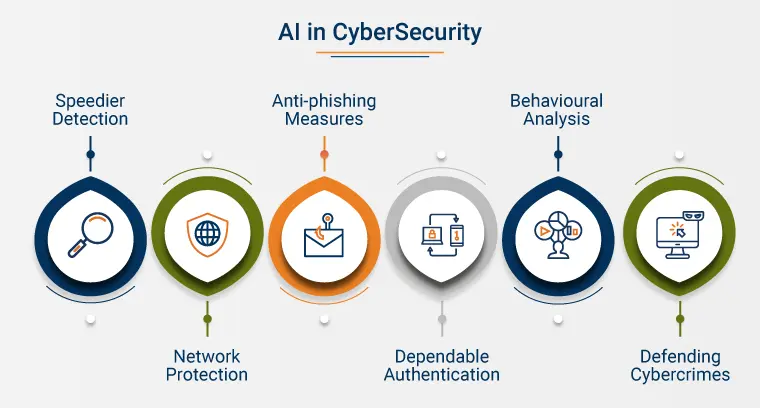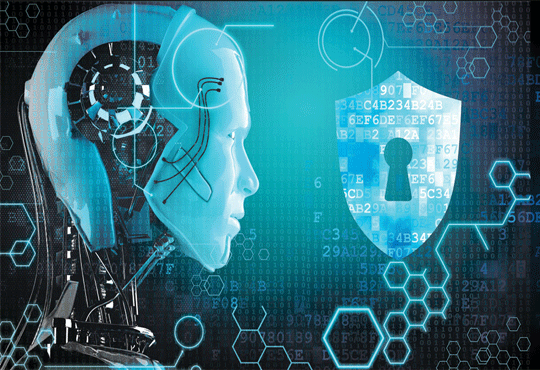The future of AI-driven cyber defense is rapidly shaping the landscape of cybersecurity. With the increasing sophistication and frequency of cyber threats, organizations are turning to artificial intelligence to bolster their defense mechanisms. AI has the potential to revolutionize the way we protect our digital assets, offering an automated and intelligent approach to identify and respond to emerging threats. From autonomous malware detection to predictive analysis, AI in cybersecurity holds immense promise in safeguarding our digital world.
AI in cybersecurity builds upon a rich history of technological advancements. Over the years, cybersecurity has evolved to address the ever-changing cyber threats, and AI has emerged as a powerful tool in this battle. By leveraging machine learning algorithms and data analytics, AI-powered systems can quickly and accurately detect malicious activities, keeping organizations one step ahead of cybercriminals. In fact, a study found that AI-enabled cybersecurity platforms can reduce detection time by up to 70% and false positives by 95%. As the volume and complexity of cyber threats continue to grow, AI-driven cyber defense will play a crucial role in securing our digital infrastructure.


The Rise of AI in Cybersecurity
The field of cybersecurity is constantly evolving, and with the increasing complexity and frequency of cyber threats, organizations are turning to artificial intelligence (AI) for better defense mechanisms. AI-driven cyber defense holds the promise of improving threat detection, response time, and overall security posture. With the ability to analyze vast amounts of data, learn from patterns, and automate processes, AI systems have the potential to revolutionize cybersecurity practices.
One of the key benefits of AI in cybersecurity is its ability to detect and respond to threats in real-time. Traditional security systems rely on predefined rules or signatures to identify malicious activities, making them limited in their ability to adapt to new threats. On the other hand, AI systems can analyze large volumes of data, including network traffic, user behavior, and system logs, to detect anomalies and identify potential threats. By using machine learning algorithms, AI systems can continuously learn from new data and update their models, enabling them to detect emerging threats that may not have been previously encountered.
Artificial intelligence can also play a significant role in automating routine cybersecurity tasks, allowing human security professionals to focus on more complex and strategic activities. Tasks such as log analysis, vulnerability scanning, and incident response can be time-consuming and resource-intensive. AI systems can streamline these processes by automating the identification and remediation of common vulnerabilities, freeing up valuable time for security analysts to investigate and respond to more sophisticated threats. By automating routine tasks, organizations can improve operational efficiency and reduce the risk of human errors.
Enhancing Threat Detection with AI
Threat detection is a critical aspect of cybersecurity, as it allows organizations to identify and respond to potential attacks before they cause significant damage. AI has the potential to greatly enhance threat detection capabilities by leveraging advanced analytics and machine learning algorithms.
1. Behavioral Analytics
Traditional security systems often rely on signature-based detection methods, which can be easily bypassed by sophisticated attackers using new or modified techniques. AI-driven behavioral analytics takes a different approach by analyzing user and system behavior to identify anomalies that could indicate a potential threat.
By establishing baseline behavior patterns, AI systems can detect deviations from normal activities and flag suspicious behavior. For example, if a user suddenly starts accessing files or systems that they do not typically have permissions for, an AI-powered system can identify and alert security teams about a potential insider threat. Similarly, AI systems can detect patterns of network traffic that deviate from expected norms, helping to identify network intrusions or unauthorized access attempts.
The advantage of using AI for behavioral analytics is that it can identify complex, multi-stage attacks that may involve multiple steps or actions. Rather than relying on individual signatures or rules, AI systems can analyze the overall sequence of events and identify suspicious patterns that could indicate a coordinated attack. This holistic view of cyber threats enables organizations to stay one step ahead of sophisticated attackers.
Benefits of Behavioral Analytics in AI-Driven Cyber Defense
- Improved detection of insider threats
- Enhanced identification of network intrusions
- Ability to detect complex, multi-stage attacks
- Reduction in false positives
- Early detection of anomalous behavior
2. Threat Intelligence
Threat intelligence refers to the knowledge and insights gained from analyzing cyber threats and understanding the tactics, techniques, and procedures (TTPs) used by threat actors. This information is crucial for organizations to proactively defend against known and emerging threats.
AI can significantly enhance threat intelligence by analyzing large volumes of structured and unstructured data from various sources, such as security blogs, research papers, and forums. AI systems can extract relevant information, identify patterns, and make connections between different data points to identify potential indicators of compromise (IoCs) or new attack techniques.
Machine learning algorithms can continuously learn from new data and adapt their models to incorporate the latest threat intelligence. This allows organizations to stay up-to-date with the evolving threat landscape and proactively implement the necessary controls and defenses to mitigate risks.
Benefits of AI-Enhanced Threat Intelligence
- Improved visibility into the threat landscape
- Proactive defense against known and emerging threats
- Faster identification of indicators of compromise
- Enhanced understanding of threat actors’ tactics, techniques, and procedures
- Better-informed decision-making for security controls
The Future of AI-Driven Cyber Defense
The integration of AI into cybersecurity practices is still in its early stages, but its potential is vast. As AI technology continues to advance, we can expect to see several key trends that shape the future of AI-driven cyber defense.
1. Enhanced Automation
As AI systems become more sophisticated, we can anticipate greater automation of routine cybersecurity tasks. Activities such as patch management, vulnerability scanning, and incident response can be further streamlined and accelerated through AI-driven automation.
Improved automation will not only save time and resources but will also reduce the risk of human error. By harnessing the power of AI, organizations can ensure that mundane tasks are handled efficiently, freeing up skilled professionals to focus on more complex and strategic cybersecurity activities.
Automation will also enable organizations to respond quickly to threats and vulnerabilities, minimizing the time between detection and remediation. This rapid response time is critical in preventing or mitigating the impact of cyber attacks.
2. Advanced Threat Hunting
Traditional threat detection methods often rely on known patterns or signatures, which can be easily evaded by sophisticated attackers. The future of AI-driven cyber defense lies in advanced threat hunting capabilities that can proactively identify and disrupt unknown or emerging threats.
AI systems equipped with machine learning algorithms can continuously learn from new data and discover hidden patterns that might indicate malicious activities. By analyzing vast amounts of data from various sources, AI-powered threat hunting can identify abnormal behaviors, indicators of compromise, and potential attack vectors.
Advanced threat hunting can help organizations stay ahead of adversaries by proactively identifying and neutralizing threats before they cause damage. By leveraging AI-driven analytics, security teams can uncover hidden threats, investigate the root cause of incidents, and take proactive actions to protect critical assets.
3. Adaptive Defense Systems
With AI-powered technologies, cybersecurity defense systems can become more adaptive and responsive. AI systems can actively learn from attempted attacks, log data, and incident response activities to refine their detection and response capabilities.
Adaptive defense systems leverage machine learning algorithms to evolve and adapt their models based on real-time insights and new threat intelligence. These systems can dynamically update their defenses and respond to emerging threats effectively.
As threat actors continuously develop new attack techniques, AI-driven defense systems will play a pivotal role in keeping organizations secure. By constantly improving their models and integrating new threat intelligence, adaptive defense systems can stay ahead of the evolving threat landscape.
Conclusion
The future of AI-driven cyber defense is promising, with the potential to revolutionize how organizations protect themselves from cyber threats. AI systems can enhance threat detection capabilities, automate routine tasks, and enable faster response times. As AI technology continues to advance, we can expect to see greater automation, advanced threat hunting capabilities, and adaptive defense systems.
Organizations that embrace AI in cybersecurity can gain a competitive edge by proactively identifying and mitigating threats, improving operational efficiency, and reducing the risk of security incidents. However, it is important to remember that AI is not a silver bullet solution—it should be used in conjunction with human expertise and a holistic cybersecurity strategy.
As the cyber threat landscape continues to evolve, the integration of AI-driven cyber defense will become increasingly crucial in safeguarding sensitive data and critical systems. It is vital for organizations to stay updated on the latest advancements and best practices in AI cybersecurity to ensure they can effectively defend against emerging threats.
While AI technology provides significant advantages in cybersecurity, it also introduces new challenges and risks that need to be carefully managed. Organizations must prioritize data privacy, transparency, and ethical considerations when implementing AI-driven cyber defense systems.
By staying informed, investing in AI-driven cybersecurity solutions, and fostering a culture of cyber resilience, organizations can navigate the future of AI in cybersecurity successfully and protect their valuable digital assets.
Key Takeaways: AI in Cybersecurity: The Future of AI-Driven Cyber Defense
- Artificial Intelligence (AI) is revolutionizing the field of cybersecurity.
- AI-powered systems can analyze vast amounts of data to identify and respond to potential threats.
- Machine learning algorithms enable AI to detect anomalies and patterns that traditional security tools may miss.
- The future of AI-driven cyber defense promises enhanced threat detection and response capabilities.
- However, human expertise and oversight are still essential in ensuring effective cybersecurity.

In summary, AI is leading the way in cybersecurity, using advanced technology to detect and prevent cyber threats.
By analyzing patterns, learning from past attacks, and adapting in real-time, AI-powered systems can provide proactive defense against a wide range of cyberattacks.


